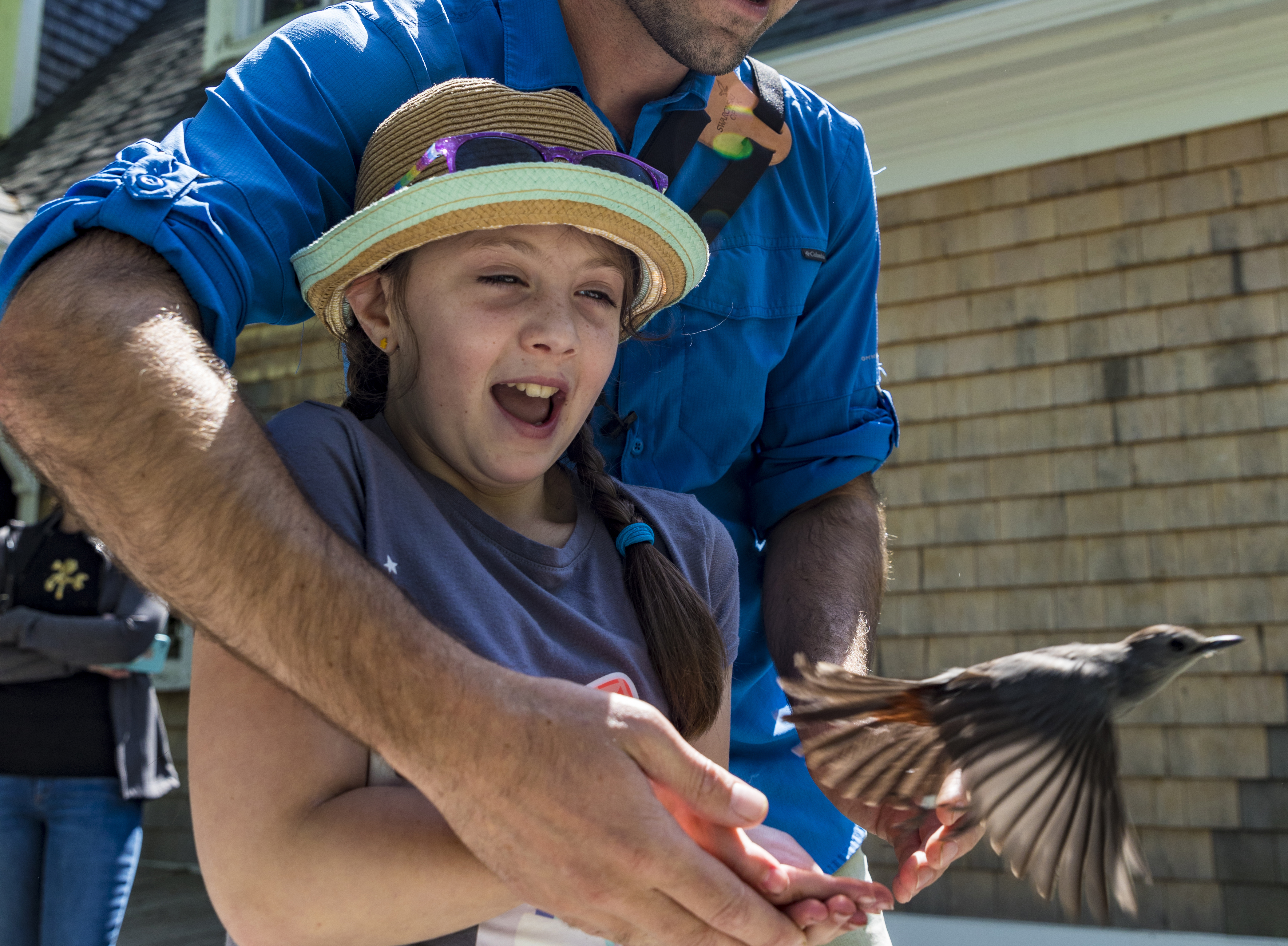Manomet’s 40 acres of coastal property boasts a variety of habitats, including freshwater wetlands, mixed forest, grassland, and saltwater. In addition to our natural wealth, Manomet is home to a rich history of ornithological observation and research, dating back to the early 1900s and continuing to this day.
For this story, we are counting down the 10 most exciting bird sightings of 2019. In 2019, a total of 231 bird species were recorded on our property by dozens of different contributing observers. Our pool of observations includes birds observed in the field, birds banded, and those recorded by our nocturnal flight call recorders. We selected the rankings based on a combination of the number of previous sightings on the property as well as the status of the species within the greater region.
So, let’s get to it! Each species account includes a testimony written by the first observer, as well as a link to the associated eBird checklist (when applicable).
10. Summer Tanager invasion – 12th and 13th banding record
Megan Gray, Lead Bander – April 25th – https://ebird.org/checklist/S55408287
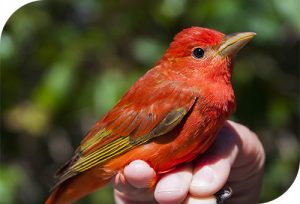
It was only the second week of the spring banding season when we had an early influx of migrants – a storm had carried many southern migrants north of their intended destinations. Jeremy excitedly came back from a net run with “a rather special capture”. I watched as he pulled a large red bird out of the bag with a large bill. A tanager? A brilliant red Summer Tanager!
This species is found far to our south in pine-oak forests. I called the main building and immediately people came rushing over to see this rare species for Massachusetts. What made this especially exciting was Sarah coming back with a second Summer Tanager just an hour later! Calling the main building again brought another rush of people to admire this second stunning bird. I watched with everyone as both birds lingered in the garden for a short while, putting on a show snapping up insects with their large yellow bills. Their rosy-red plumage stood out against the fresh green leaves that were just recently unfurled.
9. Rusty Blackbird – 7th banding record
Megan Gray – October 30th – https://ebird.org/checklist/S61044886
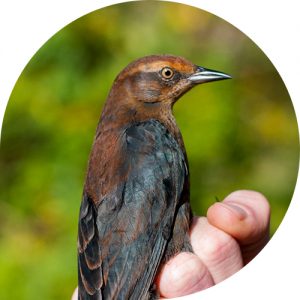
Although the forecast had called for clouds all day, we were delighted when it turned out to be warm and sunny. Returning from a net run in the afternoon with a few birds, Evan announced he had a new species for the season, one that had only been caught three times in the past 10 years in the fall! I wondered what it could be based on the size of the bird in the bag and watched as Evan pulled out a blackbird. A Rusty Blackbird had flown into our treasured Net 50 bog net! This species has unfortunately declined in recent years, as much as 90% by some estimates, from habitat loss, mercury contamination and evaporation of boreal wetlands. With a thinner bill than a Common Grackle and a pale eyebrow, I admired how the female Rusty Blackbird’s plumage gleamed a beautiful rusty and blueish black in the sunlight. Upon release )she perched in a tree just above the banding lab, sunning herself before flying away.
8. Royal Tern – 4th property record
Evan Dalton, Lead Instructor, Landbird Conservation – July 18th – https://ebird.org/checklist/S58273392
On July 18th, Alan and I went for a walk around the farm, looking for storm-blown birds in the blustery weather. Although our trip about the farm didn’t produce anything out of the ordinary, we were greeted by the unexpected at the terminus of our walk. As we approached the HQ building, I noticed a very high-flying gull-sized bird barely visible through the trees. I’m glad I put my binoculars on the bird, as I realized it was a large tern (none of the large tern species breed within the state and are uncommon to rare)! I shouted something and we both observed the bird long enough to notice the long orange bill, pale forehead and shaggy crest of a Royal Tern. As Alan ran in to grab his camera, I tried following the bird’s trajectory, but lost it over the land before he was able to document it with photos. Interestingly, observers saw a passing Royal tern near Sandy Neck on Cape Cod the same day!
7. Yellow-crowned Night-Heron – 3rd property record
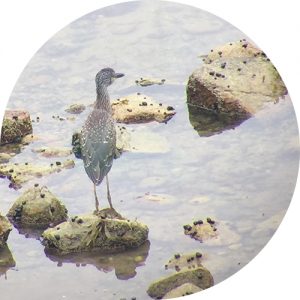
Alan Kneidel, Staff Biologist – August 5th – https://ebird.org/checklist/S58994619
On August 5th, Manomet Property Manager Tony Jones reported two Yellow-crowned Night-Herons on the rocky shoreline below the bluff. These sightings laid dormant until I returned from vacation on August 14th. After hearing the tale from Tony, I decided to follow up on the sighting, despite it being nine days ago. After peering through the heavy bluff vegetation for a minute, I spotted a moving rock. No, not a rock! A juvenile night heron feeding in the tidal pools! Long neck, long legs, and a stout all dark bill. Yellow-crowned! This species is a secretive low-density breeder in southeastern Massachusetts, most often seen as they disperse towards the coast in late summer. This summer was a good year for them, with several popping up along the south shore.
6. Chuck-will’s-widow (and Whip-poor-will) – 2nd property record
Evan Lipton, Banding Intern – May 8th-11th – https://ebird.org/checklist/S56005949
It was the morning of May 8th. I was sitting in bed deliriously at 4:40am, trying in vain to get my motors up and running. In the darkness the surprising and soft song of a Chuck-will’s-widow began to permeate my brain. About ten seconds later I realized my window was open and the call was actually coming from outside and not from the depths of my mind. Thinking quick I managed a diagnostic recording on my phone before it stopped singing. This got me pumped for the day because not only was it the second record for Manomet and an extremely unusual species locally, but it was a life bird for me.
This experience was repeated once again on the morning of May 11th (Migratory Bird Day), marking the beginning of a day when we would record an astonishing 103 species on the Manomet property. That same day was finished with a close relative of the Chuck, the Eastern Whip-poor-will singing on the farm at dusk. A wonderful thing it was to have two nightjar species at a spot where either one would be exceptional. These nocturnal oddities are also known as goatsuckers after an old erroneous belief that they would suckle from said creatures during the night. The birds were of course probably fluttering around goats for the insects they would attract and were not in fact milk thieves.
Evan Dalton – CWWI (May 15th and 16th) and EWPW (August 26th) were recorded on our farm microphone! For more information on our Nocturnal Flight Call research see below for more on the NFC project.
5. Long-tailed Jaeger (and Red Knot) – 2nd property record
Evan Dalton – August 22nd – https://ebird.org/checklist/S59187760
In my over 10-year relationship with Manomet, I have yet to make it up to Alaska to work on the various shorebird projects. I mention this only because I have never had the distinct pleasure of having a jaeger attack me. Jaegers (arctic-breeding seabirds) look like the evil cousins of our common gulls, and although their name means hunter in German, they spend a lot of their time stealing food from other seabirds like gulls and terns. In the world of sea-watching, few things are more exciting than seeing a jaeger from shore. Jaegers come in three sizes. There’s the portly Pomarine, the medium Parasitic and the slender, Laughing Gull-sized Long-tailed Jaeger. The latter had eluded me until I was scanning the horizon from the bluff at Manomet on August 22nd. Recent weather patterns had blown baitfish into the bay and larger flocks of migrating terns had begun foraging in the area for the last few days. As I was watching one of these flocks, I noticed the menacingly pointy shape of a Jaeger amongst the terns. The all dark bird lacked large white wing flashes and was noticeably small and slender: Long-tailed Jaeger! Twice I watched the bird tumble towards the water in pursuit of a Common Tern (this behavior is common in LTJA apparently) before it jetted off towards Ellisville, gaining altitude and flying over land. A brief, but fantastic experience. This followed my observation of a small flock of Red Knots flying by! This lends further evidence to the adage of ‘you never know what you’re going to see from the bluff’.
4. Pileated Woodpecker – 1st property record
Evan Lipton – May 8th – https://ebird.org/checklist/S56024412
It was a better than typical spring day. Most of the banding crew had been in the lab a few minutes prior and I had wandered by myself over to the bluff. I was soon caught by surprise by a very unfamiliar call. A loud and resonant tremolo, clearly given by a bird that was quite close. I whipped my head around but saw nothing. The call still hadn’t quite clicked in my head but I knew that I knew what it was. As I walked back over to the corner of the building, a large black and white bird flushed from the top of the tree right at the corner of the house. I stood awestruck as I watched a Pileated Woodpecker fly strongly off over the garden and south along the bluff. Fellow bander Jeremy came around the corner from the lab at that same time and by the expression on his face had clearly just witnessed the same phenomenon I had. This was the first record of Pileated Woodpecker for Manomet, a species restricted to older growth inland woods in the county, and almost never seen by the shore.
3. Sedge Wren – 1st property record
Evan Lipton – September 20th – https://ebird.org/checklist/S59971854
It was Saturday, and Lisa Schibley and I were birding the Holmes Farm for the South Shore Bird Club’s Fall Roundup. I was telling her about my possible Sedge Wren from the day before as we walked down into the farm. As I was busy relaying the sketchy details, she was focused on the marsh and at the dip in the road she was quick to get on a bird in the grasses and quicker to say “It’s right here! Sedge Wren!” I managed to get on it as well for a brief moment. Some satisfactory views were had before it seemingly skulked into oblivion.
Another first record for Manomet, Sedge Wren is a rare vagrant from prairies of the Midwest with scattered and irregular breeding locations into the east where appropriate habitat can be found. It’s hard to say how long this bird stayed at Manomet, as they can be very difficult to detect.
2. Least Bittern – 1st live property record
Evan Lipton – May 3rd – https://ebird.org/checklist/S55685387
This bird flushed from the edge of the Big Bog and was enjoyed by the entire Scituate High School ornithology class. At first glimpse, I saw a small heron with bright orangey buff wing patches, black back, and dark flight feathers. Prior to this record, Manomet’s only Least Bittern record came from a recently deceased bird found at the edge of Scokes’ Pond in 1974. The broken legs suggested a Snapping Turtle kill. That individual was prepared as a specimen and lives on in Manomet’s collection.
1. King Rail – 1st property record
Alan Kneidel – May 24th – https://ebird.org/checklist/S56694162
I woke with my phone full of messages from the banders saying Manomet was full of birds. I rushed over, eventually ending up along the edge of the Big Bog. All of a sudden, I saw a chicken-sized rail running along the path in front of me before flying into the bog itself. The rail then crouched in shallow water underneath a willow. Peering through the vegetation, I saw a long curved bill and rich chestnut coloration on the neck and flanks: King Rail! King Rails are rare summer residents in Massachusetts, favoring expansive, high-quality freshwater wetlands. During migration, they rely on wetlands big and small to rest and refuel before continuing their journey.
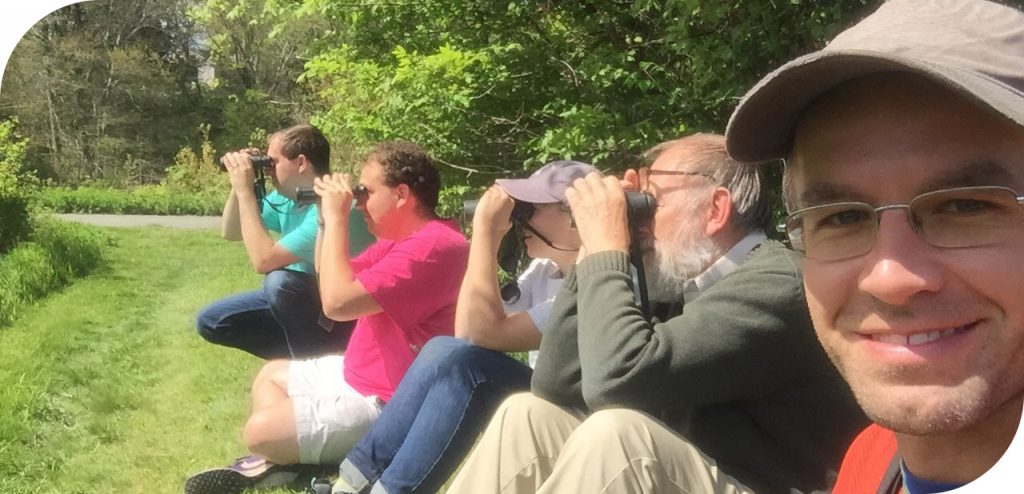
Evan Dalton – Amazingly we captured two series of ‘clapping’ vocalizations on June 6th on one of our Nocturnal Flight Call mics. Was this the same King Rail, or one migrating by at night? See below for more info on the Manomet NFC project.





 Back to all
Back to all

